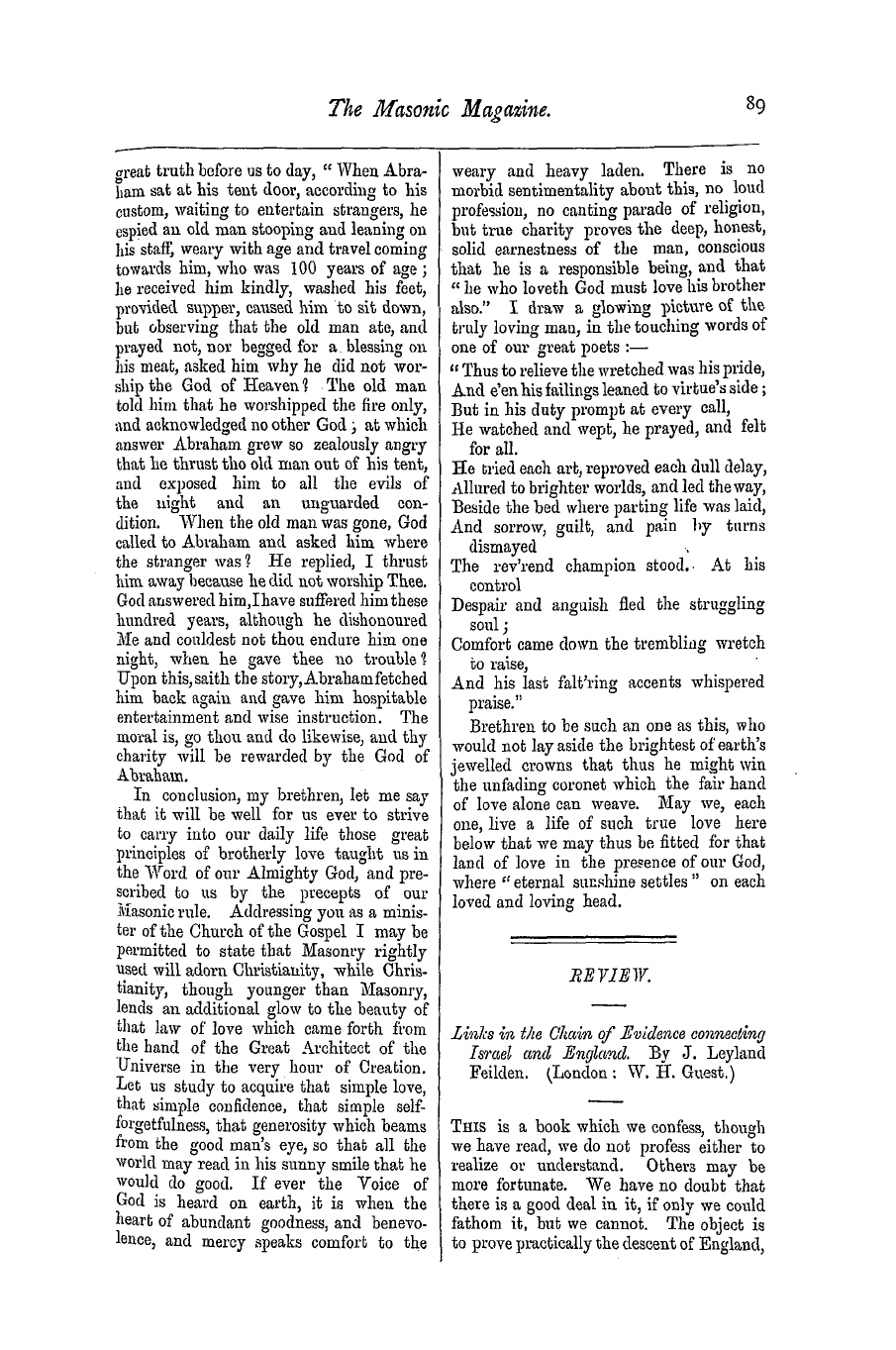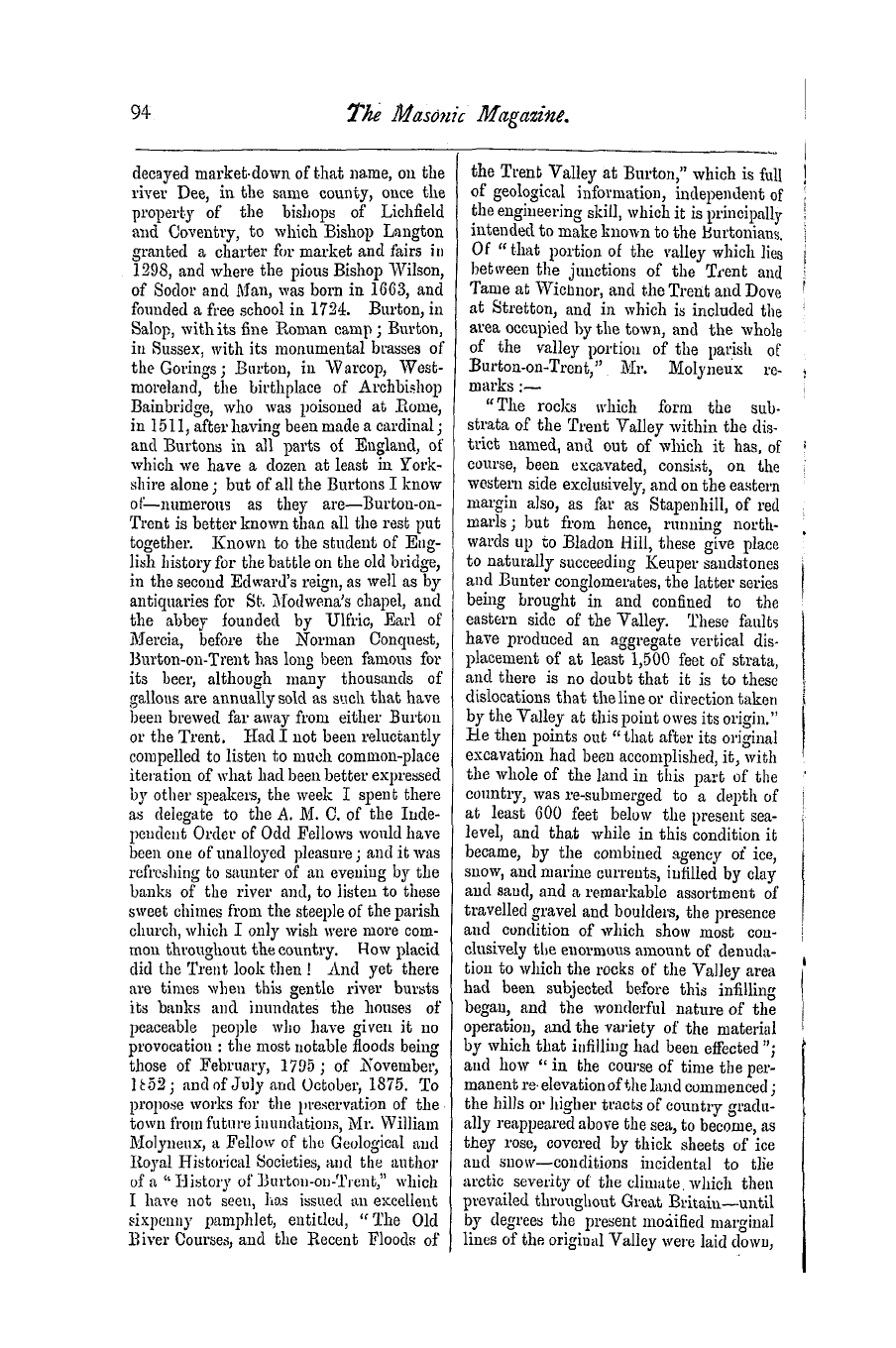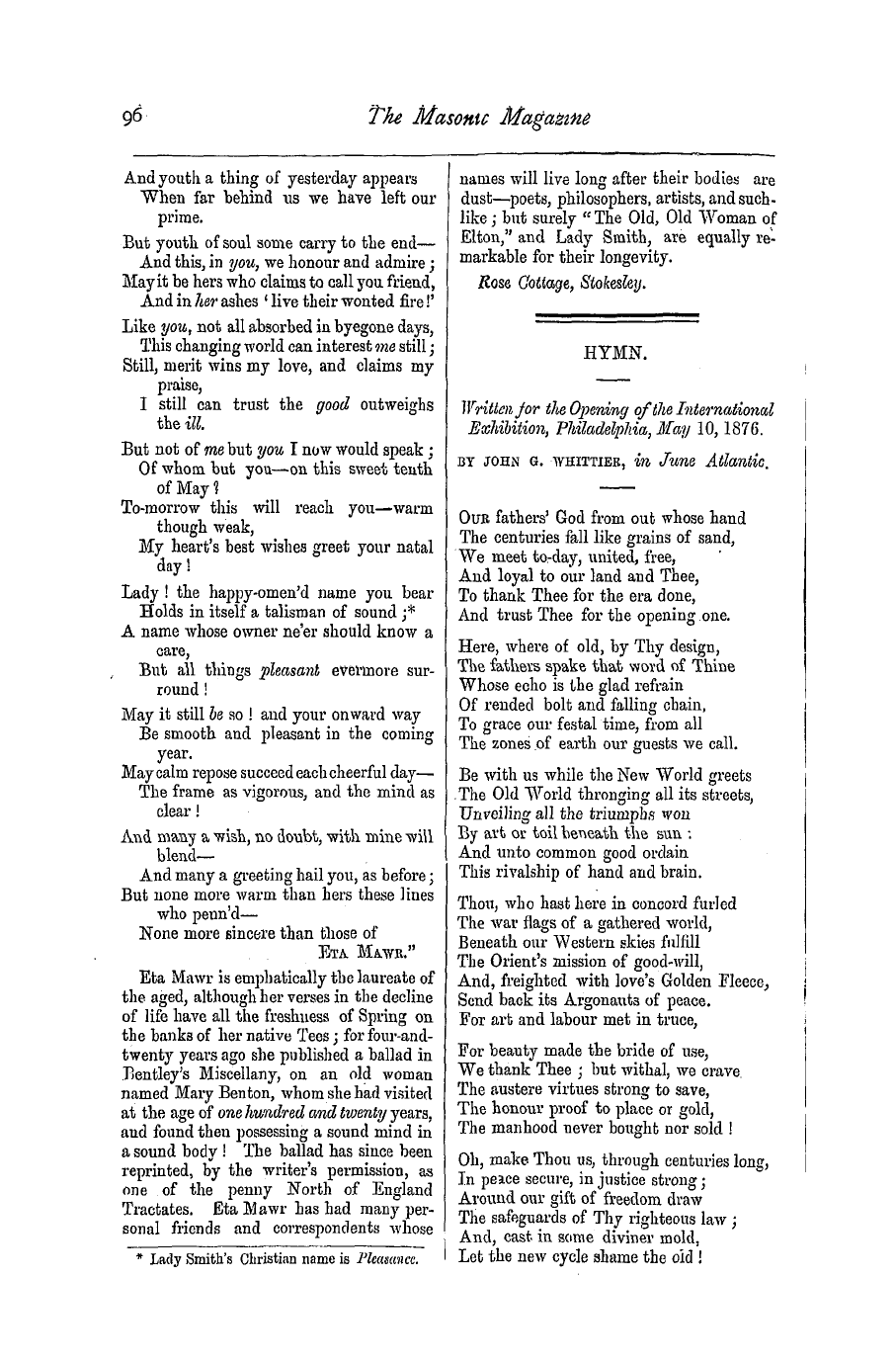-
Articles/Ads
Article AN EARLY MASONIC BOOK. ← Page 3 of 5 →
Note: This text has been automatically extracted via Optical Character Recognition (OCR) software.
An Early Masonic Book.
umbrage at those who believe the prime article of their ( that is , our ) holy faith . ( Page xi . ) The next few pages are occupied with a series of instructions to the Craft for their government in the conduct of life ,
which differ , not at all , from what are contained iu the " Old Charges , " which were published by Anderson in the succeeding year . Next follows a history of the progress of the true religion , which he claims to he that of Masonryfor the corruption of
, the antediluvian world , through the patriarchal world , and the times of the Jewish kings , until its final consummation and purification by the coming of Christ , whom he calls : Our great , our immortal Master , who
came into the world to do the will of our Father which is in Heaven and whose brethren we are ( as he says himself ) if we do so too . ( Page xxxiv . ) Having thus detailed the progress of religion , which he treats as if it were the
same thing as the progress of Masonry , he concludes by telling us what is the true Masonic profession of faith : You see now what is our profession ; it
is the law of nature , which being almost lost , was endeavoured to be retreived or at least somehow kept up by the shadows of Moses , but entirely restored by the law of grace , by Jesus Christ , the Son of God . ( Page xxxv . ) The theory advanced by Philalethes
, that the Universal Religion and Speculative Masonry are identical , and that the history of the progress of the one is that of the other , is the same as that which was advanced a century afterwards by Dr . Oliver in his " Theocratic Philosophy of
Masonry . " Unlike Anderson and the writers who followed him , Philalethes establishes no connection between Architecture and Masonry . Indeed , it is somewhat singular that although he names both David and
Solomon in the course of his narrative , it is with little respect , especially for the latter , and he does not refer , even by a single word , to the Temple of Jerusalem . Ihe Masonry of this writer is not architectural , but altogether theoseopic . It is evident that as a Hermetic philosopher he sought rather to identify the Freemasons with the disci ples of the Rosicrucian school
than with the Operative Masons of the Middle Ages . This is a point of much interest , considering that the work was published only five years after the " Revival . " It goes far to show that at that early period there was a school of Hermetic Masonry , very different in its historic theories from that established at the same
time by Desaguliers and Anderson . The following quotations , at near the close of the Dedication , will not , therefore , by its thoroughly Hermetic character , surprise the reader : And now , my Brethren , yon of the higher class , permit me a few wordssince
, you are but few ; and these few words I shall speak to you in riddles , because to you it is given to know those mysteries which are hidden from the unworthy . Have you not seen , then , my dearest Brethrenthat stupendous bath filled with
, most limpid water , than which no pure can be purer , of such admirable mechanism that makes even the greatest philosopher gaze with wonder and astonishment , and is the subject of the eternal contemplation of the wisest men . Its form is a quadrate
sublimely placed on six others , blazing all with celestial jewels , each angularly supported with four lions . Here repose our mighty King and Queen . ( I speak foolishly , I am not worthy to be of you , ) the
King shining in his glorious apparel oi transparent , incorruptible gold , beset with living sapphires : he is fair and ruddy , and feeds among the lilies ; his eyes , two carbuncles , the most brilliant , darting prolific , never-dying fires ; aud his large flowing
hair , blacker than the deepest black or plumage of the long-lived crow ; his royal consort vested in tissue of immortal silver , watered with emeralds , pearl and coral . 0 mystical union ! 0 admirable commerce ! Cast now your eyes to the basis of this
celestial structure , and you will discover just before it a large bason of porphyrian marble , receiving from the mouth of a large lion ' s head , to which two bodies displayed on each side of it are conjoined , a greenish fountain of liquid jasper . Ponder
this well and consider . Haunt no more the woods and forests ; ( I speak as a fool , ) haunt no more the fleet ; let the flying eagle fly unobserved ; busy yourselves no longer with the dancing idiot , swollen toads , and his own tail-devouring
Note: This text has been automatically extracted via Optical Character Recognition (OCR) software.
An Early Masonic Book.
umbrage at those who believe the prime article of their ( that is , our ) holy faith . ( Page xi . ) The next few pages are occupied with a series of instructions to the Craft for their government in the conduct of life ,
which differ , not at all , from what are contained iu the " Old Charges , " which were published by Anderson in the succeeding year . Next follows a history of the progress of the true religion , which he claims to he that of Masonryfor the corruption of
, the antediluvian world , through the patriarchal world , and the times of the Jewish kings , until its final consummation and purification by the coming of Christ , whom he calls : Our great , our immortal Master , who
came into the world to do the will of our Father which is in Heaven and whose brethren we are ( as he says himself ) if we do so too . ( Page xxxiv . ) Having thus detailed the progress of religion , which he treats as if it were the
same thing as the progress of Masonry , he concludes by telling us what is the true Masonic profession of faith : You see now what is our profession ; it
is the law of nature , which being almost lost , was endeavoured to be retreived or at least somehow kept up by the shadows of Moses , but entirely restored by the law of grace , by Jesus Christ , the Son of God . ( Page xxxv . ) The theory advanced by Philalethes
, that the Universal Religion and Speculative Masonry are identical , and that the history of the progress of the one is that of the other , is the same as that which was advanced a century afterwards by Dr . Oliver in his " Theocratic Philosophy of
Masonry . " Unlike Anderson and the writers who followed him , Philalethes establishes no connection between Architecture and Masonry . Indeed , it is somewhat singular that although he names both David and
Solomon in the course of his narrative , it is with little respect , especially for the latter , and he does not refer , even by a single word , to the Temple of Jerusalem . Ihe Masonry of this writer is not architectural , but altogether theoseopic . It is evident that as a Hermetic philosopher he sought rather to identify the Freemasons with the disci ples of the Rosicrucian school
than with the Operative Masons of the Middle Ages . This is a point of much interest , considering that the work was published only five years after the " Revival . " It goes far to show that at that early period there was a school of Hermetic Masonry , very different in its historic theories from that established at the same
time by Desaguliers and Anderson . The following quotations , at near the close of the Dedication , will not , therefore , by its thoroughly Hermetic character , surprise the reader : And now , my Brethren , yon of the higher class , permit me a few wordssince
, you are but few ; and these few words I shall speak to you in riddles , because to you it is given to know those mysteries which are hidden from the unworthy . Have you not seen , then , my dearest Brethrenthat stupendous bath filled with
, most limpid water , than which no pure can be purer , of such admirable mechanism that makes even the greatest philosopher gaze with wonder and astonishment , and is the subject of the eternal contemplation of the wisest men . Its form is a quadrate
sublimely placed on six others , blazing all with celestial jewels , each angularly supported with four lions . Here repose our mighty King and Queen . ( I speak foolishly , I am not worthy to be of you , ) the
King shining in his glorious apparel oi transparent , incorruptible gold , beset with living sapphires : he is fair and ruddy , and feeds among the lilies ; his eyes , two carbuncles , the most brilliant , darting prolific , never-dying fires ; aud his large flowing
hair , blacker than the deepest black or plumage of the long-lived crow ; his royal consort vested in tissue of immortal silver , watered with emeralds , pearl and coral . 0 mystical union ! 0 admirable commerce ! Cast now your eyes to the basis of this
celestial structure , and you will discover just before it a large bason of porphyrian marble , receiving from the mouth of a large lion ' s head , to which two bodies displayed on each side of it are conjoined , a greenish fountain of liquid jasper . Ponder
this well and consider . Haunt no more the woods and forests ; ( I speak as a fool , ) haunt no more the fleet ; let the flying eagle fly unobserved ; busy yourselves no longer with the dancing idiot , swollen toads , and his own tail-devouring



















































